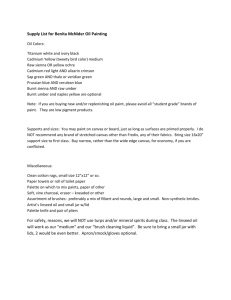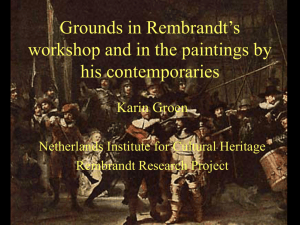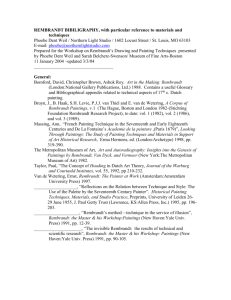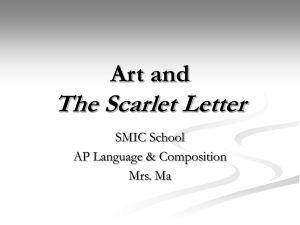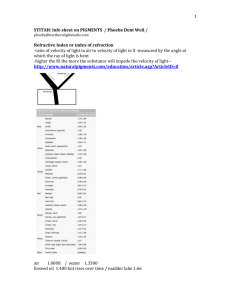Rembrandt and Burnt Plate Oil
advertisement
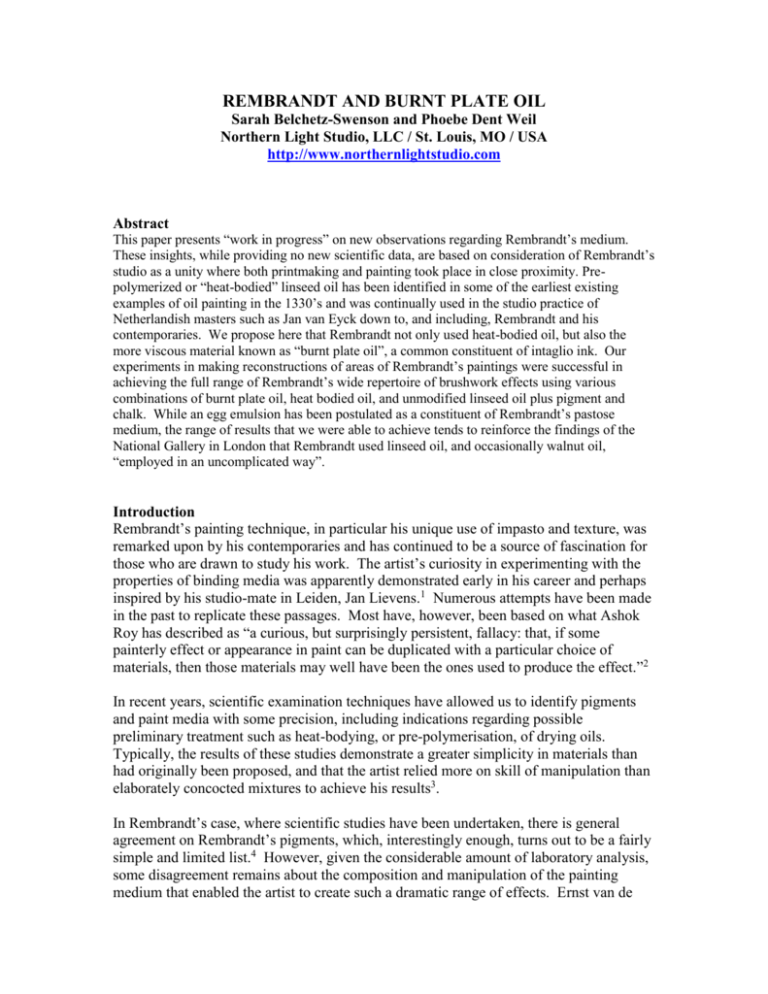
REMBRANDT AND BURNT PLATE OIL Sarah Belchetz-Swenson and Phoebe Dent Weil Northern Light Studio, LLC / St. Louis, MO / USA http://www.northernlightstudio.com Abstract This paper presents “work in progress” on new observations regarding Rembrandt’s medium. These insights, while providing no new scientific data, are based on consideration of Rembrandt’s studio as a unity where both printmaking and painting took place in close proximity. Prepolymerized or “heat-bodied” linseed oil has been identified in some of the earliest existing examples of oil painting in the 1330’s and was continually used in the studio practice of Netherlandish masters such as Jan van Eyck down to, and including, Rembrandt and his contemporaries. We propose here that Rembrandt not only used heat-bodied oil, but also the more viscous material known as “burnt plate oil”, a common constituent of intaglio ink. Our experiments in making reconstructions of areas of Rembrandt’s paintings were successful in achieving the full range of Rembrandt’s wide repertoire of brushwork effects using various combinations of burnt plate oil, heat bodied oil, and unmodified linseed oil plus pigment and chalk. While an egg emulsion has been postulated as a constituent of Rembrandt’s pastose medium, the range of results that we were able to achieve tends to reinforce the findings of the National Gallery in London that Rembrandt used linseed oil, and occasionally walnut oil, “employed in an uncomplicated way”. Introduction Rembrandt’s painting technique, in particular his unique use of impasto and texture, was remarked upon by his contemporaries and has continued to be a source of fascination for those who are drawn to study his work. The artist’s curiosity in experimenting with the properties of binding media was apparently demonstrated early in his career and perhaps inspired by his studio-mate in Leiden, Jan Lievens.1 Numerous attempts have been made in the past to replicate these passages. Most have, however, been based on what Ashok Roy has described as “a curious, but surprisingly persistent, fallacy: that, if some painterly effect or appearance in paint can be duplicated with a particular choice of materials, then those materials may well have been the ones used to produce the effect.”2 In recent years, scientific examination techniques have allowed us to identify pigments and paint media with some precision, including indications regarding possible preliminary treatment such as heat-bodying, or pre-polymerisation, of drying oils. Typically, the results of these studies demonstrate a greater simplicity in materials than had originally been proposed, and that the artist relied more on skill of manipulation than elaborately concocted mixtures to achieve his results3. In Rembrandt’s case, where scientific studies have been undertaken, there is general agreement on Rembrandt’s pigments, which, interestingly enough, turns out to be a fairly simple and limited list.4 However, given the considerable amount of laboratory analysis, some disagreement remains about the composition and manipulation of the painting medium that enabled the artist to create such a dramatic range of effects. Ernst van de 2 Wetering’s proposal, based on scientific studies undertaken for the Rembrandt Research Project, maintains that Rembrandt used an egg-oil emulsion to achieve a paint with greater body and fluidity in manipulation, and speculates that this was a “workshop secret” in Rembrandt’s time.5 Bomford, et. al. 6 and White and Kirby7 are convinced on the basis of scientific studies undertaken at the National Gallery London, that, “Rembrandt largely relied on the use of a simple oil medium, generally linseed oil, occasionally modified by heat-bodying…..The production of an impasto by the use of heat-bodied oil or alternatively, by bodying the paint with pigment, also appears general.”8 Rembrandt’s studio: painting and printmaking Printmaking was as important an aspect of Rembrandt’s work as painting, but unlike many painters who used professional printers or publishers, Rembrandt printed his plates in his own studio. In his workshop, therefore, in addition to painting materials, he would have had intaglio supplies, and given the small scale and proximity of the space for the two activities it would seem highly likely, if not inevitable, that materials such as linseed and walnut oil, pigments, and tools of all varieties were used for both enterprises. Rembrandt’s ink has been only tentatively investigated, though Margaret Holben Ellis has observed that the ink used in Rembrandt’s etchings are, like many early printing inks, radio-opaque. Since one of these inks studied by Ellis was found to contain lead, the presumption is that they were most likely produced from linseed oil boiled with litharge, or lead oxide, used at least since the 15th century to serve as a siccative.9 When we approached the question of Rembrandt’s painting medium from the broader perspective of a “dual-purpose” studio, we found that there is a standard component in etching ink, namely burnt plate oil, that might well be capable of producing impasto effects in oil paint. Burnt plate oil is raw linseed oil that has been heated to about 425ºc, or until it ignites and becomes very thick and viscous. Because of its notable viscosity, it is well suited for use in printing ink. Several early recipes for the heat-preparation of oil to be used for printing ink can be found in C.H. Bloy’s History of Printing Ink Balls and Rollers 1440-1850, most notably the description by Abraham Bosse first published in 1645:10 …first, you must take a good quantity of the purest nut-oyle and put it into a large Iron-pot, to which is fitted a cover which must lye exactly close. Fill it within 4 or 5 Inches, and then apply the cover: Thus set it or hang it on a good fire, letting it boyle, least it endanger the house, and therefore your eye must be continually upon it, to keepe it in motion and stir it about with some Iron ladle or spatula; soe as being now very hott it may take fire gently of it selfe. Or be easily inflamed with the blaze of a paper, as wine is burnt: When thus it has taken fire, remove it from the Trevet, to a corner of the chimney perpetually stirring it, yet soe as the burning may continue above halfe an hower: and this to make the weaker sort: after it has thus burnt, clapping the cover upon the pot it will be extinguished, provided it be very close, other wise you must cast a cloath upon it, which will 2 3 immediately suffocate the flame. Then let it coole a little, before you poure it into the vessel, in which you intend to keepe it. When this is don, fill the pott againe with more raw nut-oyle, as you did before: To make a stronger sort boyling it in the same manner, with this onely difference, that it is to be suffered to burne a great deale longer, moving and stirring it till it become very thick and glewy, filing and drawing into threads like a syrupe, which you may essay from tyme to tyme, by letting a few droops cool upon the plate. There are some who boyle an onion, or a crust of bread in the oyle, to render it (as they thinke) less greasie. Experimental tests and reconstructions To test the theory that the addition of burnt plate oil might render oil paint capable of producing a wide range of impasto effects, we made several batches of burnt plate oil adapted from the recipes given below, both basically similar to the 17th century recipe of Bosse, but taken from two modern printmaking manuals. Fill a large metal drum or a pot about half full with old (but not rancid) raw linseed oil. From one-half to two thirds bulk will be lost in the boiling process. The pot should not be too full because it might boil over and ignite; the lid should be available to smother any accidental fire. The oil is boiled until it becomes thick and stringy. It is then ignited, the pot is removed from the fire, and the boiling oil stirred for a few minutes. The flames should subside as soon as the stirring is stopped, but if they do not the fire can be smothered with the lid. To determine whether the oil is of proper consistency, remove a little on a stick and test its ability to pull out into strings. A good plate oil should pull out into strings a foot long. If the oil does not meet these requirements, put it back on the fire and test it until it does. The oil can never be too thick; the best printing ink can be made by grinding it in oil so thick that it will not flow. 11 Plate oil (burnt linseed oil) for intaglio ink…is made by heating raw linseed oil at its boiling point for four to six hours when a violent oxidation occurs during which the oil usually takes fire spontaneously. When cool it is greenish in color, very viscous, and has a characteristic smell of acrylic acid12 We made our initial batches of plate oil on November 1st and 2nd, 2003. Working outdoors, we heated one pint of Swedish raw linseed oil13 on a simple hotplate set on “high”. After a while, the surface of the oil began to quiver and smoke and then boil. We tested it periodically as instructed for “threading ability”, and after about an hour the oil spontaneously caught fire. We immediately removed the pot from the heat, covered it, and gradually the flames subsided. The burnt oil was thick and viscous as described and capable of forming threads a foot long. After removing a sample, we cooked the oil a while longer and got several even more viscous specimens. 3 4 We then made paint by grinding Cremnitz white (lead white) pigment with drying linseed oil and small amounts of the burnt plate oil and chalk. By varying the amounts and proportions of these materials, we produced paint with properties ranging from long and viscous to short and stiff. Working with this paint we were able to approximate a range of Rembrandt’s impasto effects, from the delicate strands of Delilah’s necklace in Samson and Delilah (Berlin, Gemäldegalerie) to the built-up passages of stiff paint in The Jewish Bride (Amsterdam, Rijksmuseum) and elsewhere.14 Burnt plate oil is dark, and it may be asked whether its use alters white or light colors. Rembrandt’s light pigments, principally lead white, lead tin yellow and yellow ochre, are opaque and have good covering power. Although walnut oil is sometimes recommended for use with light colors, Rembrandt’s occasional use of walnut oil was not restricted to light pigments.15 Moreover, there are some forms of linseed oil, i.e. sun-bleached oil, drying oil and stand oil, that are as pale or paler than raw or refined walnut oil. We conclude from our observations that neither the subtle color variations between types of oil nor the inclusion of a small amount of burnt plate oil make any noticeable difference in the overall color of paint. The perception of color is relative, and what reads as white in a low-keyed painting by Rembrandt may elsewhere look darker than what we would normally call white. The presence of chalk in Rembrandt’s paint has been noted in a number of studies16, and as mentioned earlier, we experimented by adding chalk in various amounts to our pigment. Chalk, which becomes transparent in oil, can make an opaque pigment like yellow ochre into a glaze and can give body to lakes and other transparent colors. When we added chalk to our paint in combination with burnt plate oil, we found that it enhanced the oil’s effectiveness in creating textures. Rembrandt might also have had chalk or whiting in his print shop where it is sometimes used in the final stage of hand wiping a plate. The importance of using burnt plate oil in making printing ink seems to have been significant, as stated in one description of 19th century ink making: The essential thing is to get burned oil, as boiling is not enough. The oil is placed in caldrons under which fires are lighted. When the boiling point is reached red hot pokers are plunged into it. It is burned from six to ten hours. The longer the burning the thicker the oil. This burning of the oil was one of the most picturesque features of old printing establishments17 Summary 1. Rembrandt produced his paintings and prints in adjoining workspaces, and it is useful to keep this in mind when examining his materials and methods. 2. The addition of a small amount of burnt plate oil along with chalk makes it possible to approximate Rembrandt’s impasto effects in painting. 3. The color of a drying oil does not make a noticeable difference in oil paint. 4 5 1 Van de Wetering, Ernst, Rembrandt: the Painter at Work (Amsterdam: Amsterdam University Press), 1997, pp.176-77. 2 Roy, Ashok, “Van Eyck’s Technique: the Myth and the Reality, I”, Investigating Jan van Eyck, S. Foister, S. Jones and D. Cool, eds. (Turnhout, BE:Brepols Publishers) 2000, p. 98. 3 See, for example, the results of studies on Jan van Eyck by Ashok Roy, op.cit., p. 99; as well as the studies on Rembrandt by D. Bomford, C. Brown and A. Roy, Art in the Making:Rembrandt (London:National Gallery) 1988, pp. 26, 28-29. 4 Bomford, D., C. Brown and A. Roy, op.cit; and White, R. and Jo Kirby, “Rembrandt and his Circle:Seventeenth-Century Dutch Paint Media Re-Examined”, National Gallery Technical Bulletin (London:National Gallery) 1994, pp.64-77. 5 Ernst van de Wetering, op. cit., pp. 234-39. 6 Bomford, et. al., op.cit. 7 R. White and J. Kirby, op. cit. 8 R. White and J. Kirby, op. cit. p. 68 9 Margaret Holben Ellis, private communication. Numerous recipes for boiling oil exist in the early literature, including those where litharge is added as a dryer. These include Cennino Cennini (c. 1390-1400) who describes boiling oil to use as a mordant (ch. 91), the Volpato MS (after 1670) in Merrifield, (pp. 740-741); De Mayerne MS (1620). The 15th century recipes for drying oil are discussed in Renate Keller, “Leinöl als Malmittel”, Maltechnik, 2, pp. 74-105. Rembrandt’s use of heat-bodied oil is discussed in: R. White and J. Kirby, “Rembrandt and his Circle: Seventeenth-Century Dutch Paint Media ReExamined”, National Gallery Technical Bulletin, vol. 15 (London:National Gallery Publications) 1994 p. 68; and in R. White, J. Pilc, and J.Kirby, “Analyses of Paint Media”, National Gallery Technical Bulletin, vol. 19, 1998, pp. 75, 81, and tables on pp. 87ff. 10 Abraham Bosse, Traicté des Manières de Graver en Taille-Douce l’Airin, Paris, 1645, tr. John Evelyn; in C.H. Bloy, A History of Printing Ink Balls and Rollers 1440-1850, pp. 101-102. 11 Gabor Peterdi, Printmaking: Methods Old and New, rev.ed. (New York:Macmillan) 1971, pp. 176-77. 12 S.W. Hayter, New Ways of Gravure (NY:Pantheon) 1949, pp. 33, 128-129. 13 Kremer Inc., #73020. 14 The pastose paint on the sleeve of The Jewish Bride appears to have been applied on the surface using a square-edged spatula that was 1.4 cm. wide. 15 D. Bomford, et. al., op. cit, p. 26. 16 D. Bomford, op. cit., p. 22. 17 George T. Plowman, Etching and Other Graphic Arts, (London:John Lane Co.) 1914. 5

